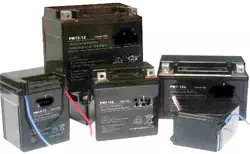|
 Lead acid batteries are made of lead plates, usually encased in plastic and containing an acid electrolyte, such as sulfuric acid. These batteries are commonly found in cars, trucks, boats, and have many other applications. They typically have a life span of 3 to 10 years. Spent lead-acid batteries (SLABs) must be properly handled to avoid breakage, spillage, and leaks, which can cause lead and/or acid contamination of the environment. Spent-lead acid batteries (SLABs) are considered hazardous wastes. SLABs may also be managed under the special management standards for universal waste. The requirements for exporters who wish to ship spent lead-acid batteries (SLABs) to other countries for recycling or recovery depend in part on the desired destination country. Lead acid batteries are made of lead plates, usually encased in plastic and containing an acid electrolyte, such as sulfuric acid. These batteries are commonly found in cars, trucks, boats, and have many other applications. They typically have a life span of 3 to 10 years. Spent lead-acid batteries (SLABs) must be properly handled to avoid breakage, spillage, and leaks, which can cause lead and/or acid contamination of the environment. Spent-lead acid batteries (SLABs) are considered hazardous wastes. SLABs may also be managed under the special management standards for universal waste. The requirements for exporters who wish to ship spent lead-acid batteries (SLABs) to other countries for recycling or recovery depend in part on the desired destination country.
Nearly 90 percent of all lead-acid batteries used in the U.S. are recycled. Almost any retailer that sells lead-acid batteries collects used batteries for recycling, as required by most state laws. Reclaimers crush batteries into nickel-sized pieces and separate the plastic components. They send the plastic to a reprocessor for manufacture into new plastic products and deliver purified lead to battery manufacturers and other industries. A typical lead-acid battery contains 60 to 80 percent recycled lead and plastic.
Although most domestic SLABs are recycled in the US, some are exported to Canada, Mexico, and other countries for reclamation. In July 2010, EPA revised Resource Conservation and Recovery Act (RCRA) rules regarding the export of spent lead-acid batteries. The revised regulations provide stricter controls and greater transparency for exports of SLABs, and they ensure that SLABs are sent to countries and reclamation facilities in those countries that can manage the SLABs in an environmentally sound manner. For example, the regulations add export notification and consent requirements. The is rule makes EPA's RCRA hazardous waste transboundary shipment regulations more consistent with those of the Organization for Economic Cooperation and Development (OECD).
Starting January 2022, EPA transitioned to a new system for processing hazardous waste export and import notices called RCRAInfo WIETS (Waste Import Export Tracking System). The new electronic system, which must be used for SLAB exports, will give U.S. exporters the ability to create notices and submit them to EPA.
Starting on December 31, 2017, all U.S. exporters of manifested hazardous waste, universal waste, and spent lead-acid batteries for recycling or disposal, and all exporters of cathode ray tubes for recycling will be required to file EPA information in the Automated Export System (AES) or AESDirect for each export shipment. The AES resides in the U.S. Customs and Border Protection's (CPB's) Automated Commercial Environment (ACE). Paper processes are no longer permitted View more information on the Automated Export System (AES).
More Resources
Revisions to OECD Imports and Exports Rule (EPA). Provides links to the federal Register notice, background information and other useful documents.
Frequently Asked Questions: SLABs. EPA has prepared an extensive list of FAQs covering technical aspects of SLABs and the revised export rules.
|
